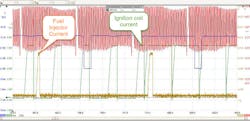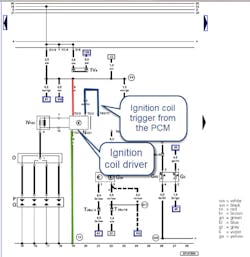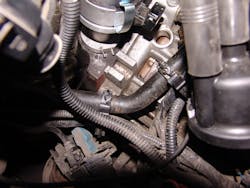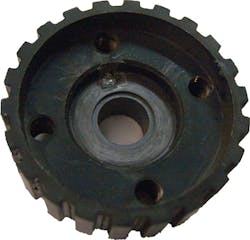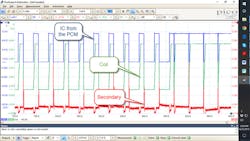Repeat ignition coil failures: A lesson in troubleshooting
This article was originally published Aug. 26, 2019. Some of the information may no longer be relevant, so please use it at your discretion.
Every now and then an interesting diagnostic problem comes into the shop. Many of these problem vehicles come from other shops and many of the vehicles have been backed up to the parts store and loaded up with everything in sight. This 2001 VW Cabrio was one of those vehicles.
You might think a car this old would be a car that nobody would invest any money in, but please keep in mind, beauty is in the eye of the beholder, and when a person loves their car, takes great care of it, and keeps up on the maintenance, the vehicle will last a long time. While I had this car apart, the lady owner walked into the shop and loudly exclaimed, “MY BABY.” I think she had a love affair with this car.
"Baby" has a problem
The story of the problem started out about six months earlier. The lady owner was on her way home from work on Friday evening. Her commute was 134 miles. She was 50 miles from home when the engine lost power and died.
The car was loaded on a flatbed and hauled to a shop that specialized in VW, Mercedes Benz and Volvo vehicles. The shop found the problem was caused by a bad ignition coil, so a new coil was installed. The engine started and ran okay and was driven about two weeks before the engine stalled again.
The vehicle was hauled back to the European shop, only to find the shop had closed its doors so the vehicle was hauled to another shop for the needed repairs. At shop No. 2, they replaced the ignition coil, put in a used ECM, installed a new distributor and put on a new MAF. The vehicle was driven for two weeks and stalled again.
The car was taken back to the shop where they found the ignition coil had failed yet again. A new OE coil from the dealer was installed. This repair also lasted about 2 weeks, then the stalling problem reoccurred. At this point, the car was brought to my shop to be fixed.
Each time the engine stalled, the problem has been the ignition coil quit making spark and installing a new ignition coil got the engine running again. Any time I hear something like this, my mind always wonders if the problem is really an ignition coil or is the defective ignition coil a product of something else that is causing the ignition coil to fail?
Let's take a look
With the Cabrio at my shop, I found the engine could be started. It would run about 15 minutes and then stall. The engine could be restarted, and it would run and then stall again. Each time the running time would get shorter until it would not run at all.
On any problem like this, my first step is to always take a look at anything stored in the computer’s memory. A scan tool was hooked up, and all modules scanned for any clues that might have been stored in memory. There are a few codes stored in the ABS module and two codes stored in the PCM.
Code P0341 (Camshaft Position Sensor circuit range/performance) and P0102 (MAF flow too low). The P0341 code is set by the CMP, and the CKP signal correlation being wrong. My gut feeling is the P0102 code is set by the engine not breathing properly.
Clearing the codes, starting the engine, and running a few seconds until it will stall will cause both codes to come back. At times, the codes must be cleared before the engine will restart. This engine will run with the CMP sensor unplugged, so the P0341 code is not an issue with the stalling problem.
My first question was, “What is going away, spark or fuel? To answer this question, I used two current probes and my lab scope. One current probe went to the ignition coil power feed while the second went to the No. 4 fuel injector power feed.
I also hooked a voltage probe to the CKP and CMP sensors. The engine was started and allowed to run until it stalled. At this point, I have my first test results to find a direction.
What has changed?
In Figure 1, the waveform shows a problem with the ignition coil current. Something has caused the coil on time to suddenly increase to the point that would overheat an ignition coil.
My next question is, “What is causing this problem? Is it the ignition coil itself? Is it an input to the PCM or is it the PCM that is causing the destruction of the ignition coils?"
The ignition system on this engine is a distributor ignition system with the CMP (Camshaft Position Sensor) housed inside of the distributor. The ignition is triggered from a CKP (Crankshaft Position Sensor) that reads from the reluctor on the crankshaft. The CMP has no effect on the ignition system and is used only to identify cylinder 1 position. Let’s take a look at a wiring diagram to see how this circuit is designed.
The wiring diagram in Figure 2 shows the single ignition with a built in driver housed in the ignition coil. There are only three wires to the ignition coil; power, ground, and the trigger from the PCM. The haunting question is what is causing this car to destroy its ignition coils? So far in the repair history, it has had three different coils installed. The first two were an aftermarket part, and the last coil was purchased from a VW dealer. All coils failed in the same manner.
Any time I am confronted with a problem like this, I will ask myself what has changed? After all, this vehicle is over 10 years old. I can understand it having one ignition coil failure, but not three. What has changed to cause this problem?
When it comes to an ignition coil failure, there are only three things that come to my mind:
- Something is causing the ignition coil to work too hard
- Something is causing the ignition coil to be turned on too long resulting in overheating
- The ignition coil has worn out from a long life
Since there have been multiple coil failures, we can rule out No. 3.
Nailing down the cause
Since I have verified the stalling problem is ignition related and is caused by the ignition coil failing when it gets hot, the next step is to find out why. We have two diagnostic trouble codes that might help give us a direction. Over my years in this business, I have seen a low flow MAF DTC stored by an engine breathing problem, so that is where I want to start my quest for information.
Since this engine has had some work done to it, I want to verify a few things. I have a cam timing code, so I want to address this first, but I feel that I might be able to fix both the low MAF flow code, and the CKP/CMP code at the same time. This engine has timing marks on both the crankshaft harmonic balancer and the flywheel.
The flywheel inspection plug is already missing, so it is easy to turn the engine and line up this mark. In Figure 3, you can see the mark on the flywheel is in the correct position. I have taken the hold down clamp off the distributor, and the aligning pins are not in the correct position.
Since the timing belt cover is already loose, let’s have a look at the marks on the camshaft sprocket. With the crankshaft mark at TDC, I found the mark on the cam sprocket is 1-1/2 teeth advanced (Figure 4). Removing the clamp from the distributor, I found the distributor had been installed in the wrong position, possibly in an attempt to eliminate the P0341 code. I feel that the cam is out of time (which lowers the volumetric efficiency of the engine), and this might be the cause of the MAF code.
At this point, the engine was in need of a timing belt so a new belt was installed. During the belt installation process, I removed the crankshaft sprocket. The bolt holding the sprocket on was very tight.
After talking to the vehicle owner, I learned that the belt had never been changed, but when I removed the sprocket, I found the locating lug was broken in the gear (Figure 5). Finding this explained why the timing belt was 1-1/2 teeth out of time.
With the new timing belt installed, and the distributor properly installed, the P0341 DTC is gone. The vehicle was test driven for a few miles; the engine runs good, although it seems to lack power especially at high RPM. With the vehicle at the shop, the engine was run at 1500 RPM for about half an hour when the engine stalled, and this waveform was captured (Figure 6).
Better but not fixed yet
The waveform shows the ignition coil current following the command from the PCM. I had to ask myself, "Is the PCM supplying a pulsed signal to trigger the driver in the ignition coil or is the PCM pulling the 12V output from the coil driver low to trigger the coil?"
To answer this question, I unplugged the ignition coil and put a power and ground to the coil. I then had 12V on the signal wire from the ignition coil, so the PCM is in charge of pulling the circuit low to trigger the coil. My next question was, "What is causing the PCM to suddenly increase the on time of the coil, causing it to self-destruct?"
In researching this coil driver, I found it is a “smart driver” and has the ability to report back to the PCM. Things like misfires and KV demand, so the PCM can make adjustments to the control of the ignition coil. In this case, the ignition coil is overheating, and then the coil driver goes and loses its mind and turns the coil on way too long, resulting ultimately in the engine stall.
When it comes to an ignition coil being over worked, there are three things that come to mind:
- The resistance in the secondary is too high
- The air fuel ratio is too lean
- The coil driver is leaving the coil on too long
I think I can rule out the problem of the coil driver since there are no problems with the coil on time until the coil overheats. That leaves only fuel mixture and secondary ignition.
In going over some of my scope captures of the secondary ignition, I noticed the engine would idle with a KV spike from 9KV-15KV, depending on engine RPM. This is a little higher than normal, although this in itself shouldn’t cause coil failure. The only thing left is air/fuel ratio. This makes me kick myself in the back side since I did not take a look at the fuel trim at all. In fact, it totally slipped my mind.
Fuel trim provides the clue
Going back to the stored diagnostic trouble codes, the P0341 has been fixed with the new timing belt. I thought the P0102 DTC would also go away when I got the engine to breathe properly, but now it’s time to address this problem. With my Ross-Tech scan tool hooked up, I noticed some data that didn’t look right.
In Figure 7 data block 2, the last two fields, injection timing and mass air flow sensor data should both be very close to each other. This is something I have paid attention to on VW vehicles over the years, it’s just one of those quirky things I look at when working on VW MAF problems. The next thing is in data block 31, field 1 and 2. VW does a great job of giving many PIDs of actual and specified. Any time you see those two together, pay close attention. In this case, the actual and specified are not even close.
The last data block, 32 tells the final story. Field 1 is showing fuel correction at idle from the oxygen sensor. This fuel trim is not like generic long term and short term — it is the actual correction at idle in field 1 and the actual trim off idle in field 2.
Trying to relate this to long term and short term in OBD2 generic will cause you to age very quickly. When this data was taken, the engine was at idle and is reporting 10 percent correction on the scan tool. To compare that to OBD II generic trim, that would be close to a 20 percent correction.
Now, without having to get out of the driver’s seat, you can watch these three data blocks, run the engine at different speeds and get a very good idea how the MAF is reporting the air being inhaled by the engine. In this case, the MAF is out on vacation. The MAF on the vehicle is a brand new part. In this case, the "NEW" means "Never Ever Worked".
A new MAF sensor was installed and the engine started and test driven. The data in Figure 8 tells the rest of the story. Data block 2, fields 3 and 4 are very close to each other. Data block 31, fields 1 and 2 are very close to each other and data block 32 fields 1 and2 are right where they are supposed to be. The problem of the coil failures is now fixed. Since these repairs were made, the vehicle has been back several times for service and has had no problems with the ignition coil.
Vehicles with problems like this, I call “sandwich vehicles” since there are so many problems all sandwiched one on top of each other and the only way you get to the bottom of the problem is by persistence and following a logical testing plan.
About the Author
Albin Moore
Albin Moore spent the first 21 years of his working life in the logging industry. In 1992 he made the transition to shop ownership and opened Big Wrench Repair in Dryden Washington. Since opening the shop he has moved the business to specialize in driveability problem analysis, both with gasoline and diesel vehicles. Albin is an ASE CMAT L1 technician, and brings with him 40 years of analyzing and fixing mechanical and electrical problems. Albin enjoys sharing his many years to experience and training with the younger generation as a way of improving the quality of the automotive repair industry.
